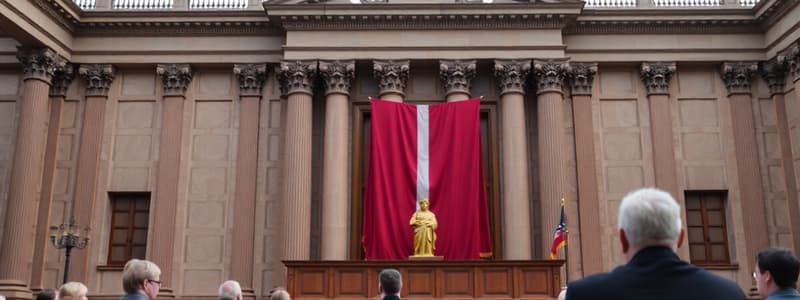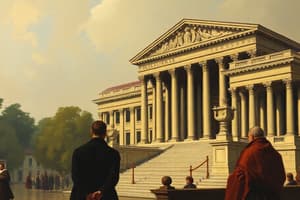Podcast
Questions and Answers
In the short case study, what should the company do when the customer sues them in the state courts of Arizona?
In the short case study, what should the company do when the customer sues them in the state courts of Arizona?
This requires legal assessment. The company will need to engage legal counsel to assess the validity of the claim, the applicability of EU vs. US laws, and the potential impact of the Supremacy Clause.
The U.S. Constitution's Supremacy Clause (Article VI, Clause 2) establishes that:
The U.S. Constitution's Supremacy Clause (Article VI, Clause 2) establishes that:
- Federal law takes precedence over state laws. (correct)
- State law takes precedence over federal laws.
- Only criminal law can be considered.
- Only civil law can be considered.
If there is a conflict between federal and state law, state law preempts federal law.
If there is a conflict between federal and state law, state law preempts federal law.
False (B)
Some powers are exclusively held by the federal government, such as:
Some powers are exclusively held by the federal government, such as:
Other powers are reserved to the states by the Tenth Amendment, such as:
Other powers are reserved to the states by the Tenth Amendment, such as:
Federal and state governments cannot legislate on certain issues, such as taxation and criminal law.
Federal and state governments cannot legislate on certain issues, such as taxation and criminal law.
What did Roe v. Wade (1973) legalize nationwide?
What did Roe v. Wade (1973) legalize nationwide?
What did Dobbs v. Jackson Women's Health Organization (2022) do?
What did Dobbs v. Jackson Women's Health Organization (2022) do?
Define natural law.
Define natural law.
Define man-made law.
Define man-made law.
Violations of law cannot carry penalties or consequences.
Violations of law cannot carry penalties or consequences.
What is 'The plaintiff'?
What is 'The plaintiff'?
What is 'The defendant'?
What is 'The defendant'?
What does the legislative branch do?
What does the legislative branch do?
What does the executive branch do?
What does the executive branch do?
What does the judicial branch do?
What does the judicial branch do?
Match the courts with their jurisdiction:
Match the courts with their jurisdiction:
Federal courts relate to matters...
Federal courts relate to matters...
State courts relate to matters...
State courts relate to matters...
U.S. courts can exercise personal jurisdiction over foreign defendants who have certain minimum contacts with the United States, this can include...
U.S. courts can exercise personal jurisdiction over foreign defendants who have certain minimum contacts with the United States, this can include...
Flashcards
Supremacy Clause
Supremacy Clause
Federal law takes precedence over state laws when there is a conflict.
Federal Exclusivity
Federal Exclusivity
Powers held exclusively by the federal government (e.g., interstate commerce).
State Exclusivity
State Exclusivity
Powers reserved to the states by the Tenth Amendment (e.g., intrastate commerce).
Concurrent Powers
Concurrent Powers
Signup and view all the flashcards
Definition of Law
Definition of Law
Signup and view all the flashcards
Substantive Law
Substantive Law
Signup and view all the flashcards
Procedural Law
Procedural Law
Signup and view all the flashcards
Burden of Proof
Burden of Proof
Signup and view all the flashcards
Common Law
Common Law
Signup and view all the flashcards
Continental Law
Continental Law
Signup and view all the flashcards
To Sue
To Sue
Signup and view all the flashcards
The Plaintiff
The Plaintiff
Signup and view all the flashcards
The Prosecutor
The Prosecutor
Signup and view all the flashcards
The Defendant
The Defendant
Signup and view all the flashcards
Criminal Law
Criminal Law
Signup and view all the flashcards
Civil Law
Civil Law
Signup and view all the flashcards
Regulatory Agencies
Regulatory Agencies
Signup and view all the flashcards
SEC
SEC
Signup and view all the flashcards
Federal Trade Commission (FTC)
Federal Trade Commission (FTC)
Signup and view all the flashcards
Internal Revenue Service (IRS)
Internal Revenue Service (IRS)
Signup and view all the flashcards
Occupational Safety and Health Administration (OSHA)
Occupational Safety and Health Administration (OSHA)
Signup and view all the flashcards
Environmental Protection Agency (EPA)
Environmental Protection Agency (EPA)
Signup and view all the flashcards
Food and Drug Administration (FDA)
Food and Drug Administration (FDA)
Signup and view all the flashcards
Long-Arm Jurisdiction
Long-Arm Jurisdiction
Signup and view all the flashcards
In Personam Jurisdiction
In Personam Jurisdiction
Signup and view all the flashcards
In Rem Jurisdiction
In Rem Jurisdiction
Signup and view all the flashcards
Federal Court Jurisdiction
Federal Court Jurisdiction
Signup and view all the flashcards
State Court Jurisdiction
State Court Jurisdiction
Signup and view all the flashcards
Beyond a reasonable doubt (Criminal Law)
Beyond a reasonable doubt (Criminal Law)
Signup and view all the flashcards
Preponderance of evidence (civil law)
Preponderance of evidence (civil law)
Signup and view all the flashcards
Study Notes
Introduction to US Law
- This is week 1 lecture, for the Fall term 2024
Short Case Study
- A French e-commerce company selling solar-powered garden gnomes ships to the US.
- An Arizona customer orders 3 gnomes.
- A gnome malfunctions and causes a fire, destroying the customer's garden and garage, containing a 1964 AC Cobra, resulting in a lawsuit seeking $5 million in damages.
Class Contents
- Introduction to US Law lecture includes:
- A historical approach to US Law
- Exploration of Federal vs State powers and supremacy
- Intro to the legal process & Procedure around State and Federal appeals, State and Federal Supreme Courts
- Overview of Administrative & Regulatory Bodies
- Examination of State, federal and long-arm jurisdiction laws
Historical Background
- The USA is a federation of 50 states, each with its own capital.
- Washington D.C. is the capital of the USA.
- The key principle is the division of powers: Executive, Legislative, and Judiciary.
- State vs Federal issues include:
- Applicable laws
- Administrative bodies
- Conflict of laws
- Hierarchy of laws, agencies,...
- Key historical dates:
- Pre-Columbus (1492): 50 to 60 million people lived in North, Central, and South America.
- 1620: Arrival of Pilgrims on the Mayflower
- 1776: Declaration of Independence with 13 colonies
- 1861-1865: US Civil War
- 1865: End of slavery
Federal & State Powers
- Mechanics of Federal and State governments mirror each other
- The Supremacy Clause in the U.S. Constitution (Article VI, Clause 2) establishes that federal law takes precedence over state laws.
- Preemption states that Federal law preempts state law if there is a conflict.
- Preemption can be express or implied.
- Exclusive federal powers include regulating interstate commerce, coining money, and conducting foreign policy.
- State powers, reserved by the Tenth Amendment, include regulating intrastate commerce, managing public health and safety, and overseeing local governments.
- Concurrent powers allow both federal and state governments to legislate on certain issues.
- Taxation and criminal law are examples of concurrent powers.
- States may enforce their own regulations as long as they do not conflict with federal laws.
Abortion Rights in the US
- Roe v. Wade (1973) provided a nationwide legalization of abortion.
- It determined that women could choose to have an abortion because of their right to privacy under the Due Process Clause of the 14th Amendment.
- Dobbs v. Jackson Women's Health Organization (2022) overturned Roe v. Wade.
- It argued that the Constitution does not guarantee a right to abortion, and individual states must decide the matter rather than federal mandate.
Nature & Source of Laws
- It is important to define the differences between natural law vs. man-made law.
- The definition of law is a series of man-made rules of conduct (often written) that define interactions between real and legal persons and their environment
- Laws Enacted and enforced by a recognized supreme body, and is enforceable through executive, administrative or legal actions that carry penalties or consequences if violated
- Laws establish minimum norms of conduct
- Substantive Law are laws that set out the rights and duties.
- Public laws define the Relationship between government and real/ legal persons, including:
Civil Law
- Disputes between individuals and organizations, it provides for the resolution of these disputes through the awarding of damages or specific
- There are administrative Laws.
- Civil Law is when a wrong is committed against another individual or organization, which is different from Criminal Law
- Criminal Law is the actions that are offenses against the public, state, or society, therefore if the immediate victim is an individual, and the wrong is committed against the society
- Private Law (civil law): Relationship between real / legal persons
- Procedural Law: Law that manages the application of substantive law (ex: laws of presenting evidence, filing procedures, ...)
- Law vs Justice vs Morality must be considered
Vocabulary
- To sue is to initiate a civil action
- To prosecute is to start a criminal action
- The plaintiff represents the actions bringing the legal action in civil law
- The prosecutor represents the state bringing a criminal action
- The defendant is the party that defends against a civil or a criminal action
- Common Law are body of laws developed through judicial decisions and precedents rather than through legislative statutes or executive actions.
- It is characterized by stare decisis when courts follow established precedents set by previous rulings, and is otherwise known as the Anglo-Saxon Systen
- Continental Law are legal systems based on written codes and statutes, and originals from Roman Law include laws that are systematically codified, where judges apply these codes to cases without relying heavily on precedents (France)
- Burden of Proof defines the obligation to present evidence to support the claim/assertion that is made
- A Judge presides over court proceedings, ensures legal rules, and makes rulings and judgments
- A group of citizens will be selected for a Jury to hear evidence in a trail so a verdict can be made based on that evidence
Civil vs Criminal Law
- Civil Law is when the "party" brings the action, and that party is the plaintiff
- Criminal Law is when the "party" brings the action, and that party is the prosecutor
- Civil Law entails "who has the burden of proof", where the party holds the "burden" of asserting claims
- Criminal Law entails "who has the burden of proof", where the party holds the "burden" of the claims
- They are typically by prosecution
- Under Civil Law the "level of burden" is determined by a preponderance of evidence
- (more likely than not)
- Under Criminal Law the "level of burden" Beyond reasonable doubt exists with a higher standard than under civil law
- Under Civil Law remedies can be achieved through Damages, or specific performance
- Under Criminal Law remedies can be achieved through Fines, Imprisonment or Capital punishment
The Court
- Federal Courts include:
- US Supreme Court
- US Courts of appeal
- US District Courts
- Specialized Federal Courts (ex: US Bankruptcy courts, US court of international trade)
- State Courts include:
- State Supreme Court
- Matters relating to state governments & foreign agents (diplomats)
- State Appeals Court
- State Trial Courts
- Local / Municipal Courts (minor matters, traffic violations, small claims, etc)
Regulatory agencies
- US regulatory agencies are empowered by Congress with legislation defining their scope,authority, and responsibilities
- The president appoints heads of agencies, with Senate Confirmation that provides further Executive oversight and direction
- They are responsible for creating and enforcing rules and regulations within specific sectors, ensuring compliance with federal laws, protecting public health, safety, and welfare, and overseeing economic and environmental practices
- Agencies are typically subject to the jurisdiction to US federal courts and answer to legislative or executive branch of the Federal government
- There are about 400 agencies in the USA
- Some of the most important U.S. regulatory agencies significantly influence business operations, compliance requirements, and industry standards are:
- Securities and Exchange Commission (SEC): Regulates the securities markets and protects investors
- Federal Trade Commission (FTC): Enforces antitrust laws and promotes consumer protection
- Internal Revenue Service (IRS): Manages tax collection and tax law enforcement
- Department of Commerce: Supports economic growth, trade, and innovation
- Occupational Safety and Health Administration (OSHA): Ensures safe and healthy working conditions
- Environmental Protection Agency (EPA): Enforces environmental regulations affecting businesse
- Food and Drug Administration (FDA): Regulates food safety, pharmaceuticals, and medical devices
- Federal Communications Commission (FCC): Regulates interstate and international communications
- Consumer Financial Protection Bureau (CFPB): Protects consumers in the financial sector
- Department of Labor (DOL): Oversees federal labor standards, including wage and hour laws
Jurisdiction
- Federal court jurisdiction occurs when there are matters relating to federal law and interstate commerce
- State court jurisdiction occurs when the Courts of general jurisdiction, within the state powers but also cases involving federal law where states have concurrent jurisdiction under the constitution
- Long Arm Jurisdiction: refers to the ability of U.S. courts to exercise personal jurisdiction over foreign defendants who have certain minimum contacts with the United States. Includes conducting business, committing a tortious act, or owning property within the U.S.
- Federal Law is jurisdiction that falls Under the US constitution or federal Crimes
- Federal Law is jurisdiction that defines disputes between states or with a foreign governement, Interstate / international commerce /Martime Law
- Federal Law is jurisdiction that concerns intellectual property as it is jurisdiction that falls under federal regulations such as Bankruptcy
- State Law is jurisdiction that deals with State crimes, Family law, Personal injury / torts and Property disputes, and is always based on contracts
In Personam & In rem Jurisdiction
- In personam jurisdiction: jurisdiction over the person, jurisdiction where the parties to the dispute reside
- In rem jurisdiction: jurisdiction over the thing- jurisdiction coming from where the property is located
- It is important to know if a court has jurisdiction based on Subject Matter / In personam or In rem for businesses
Movie Recommendations
- 12 Angry Men
- Pelican Brief
In-Class Case Studies
- There are five groups, with each group receiving their own case study.
- Groups have approximately 30-45 minutes to work on these.
- There are three goals:
- Go beyond ChatGPT, investigate
- Show proof of understaning
- Take on the teacher role and educate
Case Study #1. Federal vs. State Powers
- Task: How the conflict between federal and state laws regarding marijuana illustrates concurrent powers?
- Explore the Supremacy Clause in the U.S. Constitution that apply to this case
- Look into risks between state and federal laws?
- What are the implications for banking, taxation, and regulatory compliance?
- How might the conflict be resolved through legal or legislative means? How that could alter the impacts on sovereignty
Case Study #2: Natural vs. Man-Made Laws
- Question: How do natural law principles support the idea of environmental protection, and how are these principles reflected (or not reflected) in man-made environmental laws like the Clean Air Act?
- Question: Evaluate the Clean Air and how that correlates to principles of natural law
- Question: Consider the role/balance of the government/businesses, and if they are enforcing natural obligations
Case Study #3: Law of Justice vs. Morality
- Question: Is there a legitimate basis for refusing to comply with a law on moral grounds? What are the potential consequences of such refusals?
- Question: How will legal precedents affect Freedom?
- Question: Consider the potential impact on the rule of law if officials did not listen to the law.
Case Study #4: Substantive vs. Procedural Law
- Question: illustrate the importance of ensuring justice and the potential conflicts when procedural rules affect the outcome of a case.
- Question : Should procedural rules ever be relaxed or overridden to ensure a fair trial, explore the arguments for and against strict adherence to procedural law
- Question: Show the balance that lawyers must show and explain impacts legal strategy
Case Study #5: Civil vs. Criminal Law
- Task: How does this highlight the differences between civil and criminal law, particularly in terms of the burden of proof, legal procedures, and potential penalties?
- Discuss how these differences influence the strategies of the prosecution and the defense in each case
- Question: explore the legal system allows for parallel proceedings in civil and criminal cases and the potential outcomes for Mr. Johnson
- Question: Research and discuss the broader implications of insider trading cases for corporate governance and investor confidence.
Studying That Suits You
Use AI to generate personalized quizzes and flashcards to suit your learning preferences.



